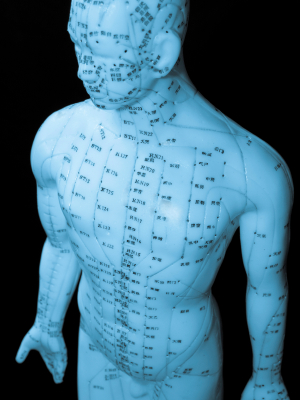An Overview of Acupuncture
Summary
Acupuncture is one of three main branches of traditional Chinese medicine, the others being herbal medicine and
tuina. It's a term most often used by Westerners in reference to the practice of inserting steel needles into
acupuncture points to achieve pain relief and healing.
Acupuncture has been in use for well over 2000 years, though there is evidence that a form of acupuncture was
used as early as the Bronze Age. It's one of the first components of Chinese traditional medicine to gain wide
acceptance in the Western world. In 1995, the FDA declared acupuncture to be safe and effective for treating some
conditions.

Theory
Traditional Chinese Medicine states that acupuncture works by balancing the flow of qi (pronounced ‘chee’) in the
body. The qi, or life force, is said to flow through all living beings, and to be comprised of positive and
negative energies. In a healthy person, the qi is balanced and flows well. Pain and illness are thought to be the
result of a blockage that prevents the qi from following the correct paths to maintain that balance. Acupuncture
treats illness and disease by unblocking the qi.
Acupuncture perceives the body as a whole, and illness as a disturbance somewhere within that whole. The actual
practice of acupuncture involves understanding the centers and meridians of the body, and where the points that
control various organs and bodily systems reside. It involves the use of pressure, often applied by inserting fine
steel needles into the body, at those points and manipulating those needles to achieve certain effects.
The Evidence
As bizarre as it may seem to the Western mind that sticking a needle into the web between thumb and forefinger can
relieve headache, there is a great deal of evidence that acupuncture works. There have been dozens of studies done
that show positive results for acupuncture in treating conditions as diverse as asthma, migraines, diabetic
neuropathy, arthritis, lower back pain, depression, painful menstruation and menopause. The National Institutes of
Health have concluded that there is enough evidence of the value of acupuncture to support further research into
its clinical value.
The Potential Risks
Acupuncture does have some associated risks. It's an invasive procedure that involves puncturing the skin, so there
is a risk of infection. There is also the potential of nerve damage caused by the needles. There have been rare
reports that deep needling in the chest or lower back area can result in damage to the lungs or the kidneys. There
is also the potential but extremely rare possibility of a haemopericardium (bleeding in the area around the heart)
if a person has a congenital abnormality in the sternum.
Final Points
Check with your state to find out what requirements are necessary for practicing acupuncture. Each state has
differing regulations. Some require licensing and special training, others allow conventional doctors with no
specific training in acupuncture techniques to apply those techniques in the office. That’s akin to saying that a
dentist is qualified to perform heart surgery because he has a medical degree.
As with any other medical treatment, conventional or alternative, do your research and know the risks and
benefits before deciding to undergo therapy.
More Acupuncture Articles
| 




